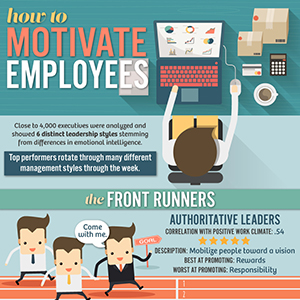Find Your Perfect Business Degree
www.business-management-degree.net is an advertising-supported site. Featured or trusted partner programs and all school search, finder, or match results are for schools that compensate us. This compensation does not influence our school rankings, resource guides, or other editorially-independent information published on this site.
Motivating employees can be tricky, but it is essential to ensure that your team feels engaged and productive. To successfully motivate your team, you need to establish clear goals, provide them with the necessary resources to succeed and recognize their successes.
You should also prioritize communication to ensure that employees understand the reasons behind their tasks and feel like they can discuss any issues or questions with you.
Additionally, providing employees with opportunities to grow and learn will help to inspire their hard work and increase their engagement. By following these strategies, you will be able to effectively motivate your team and drive better performance.
How to Motivate Employees
Close to 4,000 executives were analyzed
And showed 6 distinct leadership styles
Stemming from differences in emotional intelligence
The clincher: the top performers rotate through many different management styles throughout the week.
The Front Runners:
Authoritative leaders
Correlation with positive work climate: .54
Description: mobilize people toward a vision
Phrase: “Come with me.”
Best at promoting: Rewards
Worst at promoting: Responsibility
Affiliative leaders
Correlation with positive work climate: .46
Description: create emotional bonds and harmony
Phrase: “People come first.”
Best at promoting: Rewards
Worst at promoting: Responsibility
Democratic leaders
Correlation with positive work climate: .43
Description: build consensus through participation
Phrase: “What do you think?”
Best at promoting: Rewards
Worst at promoting: Standards
Coaching leaders
Correlation with positive work climate: .42
Description: develop people for the future
Phrase: “Try this.”
Best at promoting: Rewards
Worst at promoting: Responsibility
Not Quite as Effective
Pacesetting leaders
Correlation with positive work climate: -.25
Description: expect excellence and self-direction
Phrase: “Do as I do, now.”
Best at promoting: Responsibility
Worst at promoting: Rewards
Coercive leaders
Correlation with positive work climate: -.26
Description: demand immediate compliance
Phrase: “Do what I tell you.”
Best at promoting: Standards
Worst at promoting: Responsibility
Great leaders bring out the best in their team members by creating a positive work climate.
Emotional Intelligence Matters
Leaders with strengths in 6 or more emotional intelligence competencies are far for effective.–David McClelland, Noted Harvard Psychologist
4 large subsets of emotional intelligence
1. Self-Awareness
Components:
a. Emotional self-awareness: ability to read and understand your emotions, recognizing their impact on work and the world.
b.Accurate self-assessment: ability to realistically evaluate your strengths and weaknesses.
c.Self-confidence: do you have a strong self of self-worth?
2. Self-Management
Components:
a. Self-control: the ability to keep disruptive emotions and impulses under control.
b. Trustworthiness: consistent display of honesty and integrity.
c. Conscientiousness: the ability to manage yourself and your responsibilities.
d. Adaptability: the ability to adjust to change and overcome obstacles.
e. Achievement orientation: drive to meet an internal standard of excellence.
f. Initiative: a readiness to seize opportunities.
3. Social Awareness
Components:
a. Empathy: the ability to sense other people’s emotions, understanding, and perspective. Taking an active interest in the concerns of others.
b. Organizational awareness: the ability to read organizational life, navigate politics, and make decision networks.
c. Service orientation: the ability to recognize and meet customers’ needs.
4. Social Skills
Components:
a. Visionary Leadership: the ability to take charge and inspire with a vision.
b. Influence: the ability to be persuasive in a variety of ways.
c. Developing others: propensity to aid others in development through feedback and guidance.
d. Communication: the ability to listen and send clear and convincing messages.
e. Change catalyst: the ability to initiate new ideas and lead others in a new direction.
f. Conflict Management: the ability to de-escalate disagreements and create solutions.
g. Building bonds: the ability to cultivate and maintain a web of relationships.
h. Teamwork and collaboration: the ability to promote cooperation and team building.
Leaders with 3 or fewer emotional intelligence competencies have a much more limited range of leadership styles from which to draw.
Leaders with over 10 emotional intelligence competencies often change leadership styles rapidly, according to the situation.
Want to motivate others? Learn about yourself.
Emotional self-awareness (ESA) is one of the largest indicators of emotional intelligence, and thus leadership ability.
Motivating employees helps the bottom line
For Leaders with 6+ emotional intelligence competencies:
9/10 were in the top third of annual salary and bonuses based on business performance
Their divisions outperformed yearly revenue targets by 15-20%
Leaders who lacked 6 emotional intelligence competencies led divisions that underperformed by an average of 20%
(From An analysis of a global food and beverage company)
The Takeaway:
Emotional intelligence matters.
Management copes with complexity.
Leadership helps others cope with change.
Citations:
- “Leadership that Gets Results,” Harvard Business Review, March-April 2000
- “What Leaders Really Do,” John P. Kotter, Harvard Business Review, December 2001
- http://www.haygroup.com/downloads/ww/misc/esci_research_findings_2010.pdf

